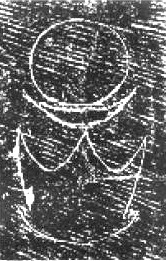Chinese characters (hanzi 漢字) are symbols of a logographic script developed for the Chinese language. The oldest traces of Chinese characters are to be found in oracle bone inscriptions from the late Shang period 商 (17th-11th cent. BCE), but precursors of characters have been detected on objects of the Erligang culture 二里岡 (1600-1400 BCE).
 |
 |
Left: Sign carved into an earthen vessel from the Dawenkou Culture 大汶口 (5000-3000 BCE). The symbol is variously interpreted as the precursor of the characters 旦 "morning", 昊 "bright sky", 杲 "sunrays" or 曍 (皥) "brilliant". From Wang 2000. Right: Rubbing of an inscription of a li 鬲-type bronze vessel with a clan insignium, reading | |
Chinese characters represent syllables, and because ancient Chinese was a highly monosyllabic language, in most cases also words. Chinese characters are no pictures (pictograms), as often believed, but symbols for words. The Chinese script is a logographic script, each character representing a word (logogram) or an "idea" (ideogram). While part of the Chinese characters is purely ideographic (representing an idea or a concept), 80 per cent of characters also include a phonetic part. The composition of Chinese characters follows strict rules and is very logical. There is a limited amount of about 2,000 components or modules that can be used to create new characters. The script is thus highly standardized and much easier to learn than commonly believed. With a basic treasure of characters (and character modules), all others can instantly be analyzed.
The following chapters describe the interplay of language and writing, the emergence, creation, and types of Chinese characters, rules of writing, writing styles, and the methods of arranging characters in dictionaries.
Through the ages, new Chinese characters were constantly invented, so that character dictionaries (zidian 字典) trying to record all ever-used characters reach a number as high as 100,000. In fact, 90 per cent of these are either outdated or writing variants, so that average dictionaries contain not more than about 10,000 characters. Even of these, two thirds are rarely used. An amount of 3,000 characters suffices to read and understand 99 per cent of all characters modern texts (not words, but characters!), with 2,000 characters, 97 per cent can be understood, and even 1,000 characters are enough to understand 88 per cent of an average text. The growing lexicon of characters is reflected in the characters recorded in dictionaries:
| dictionary | compiler | year | characters (main + alternative) |
| 倉頡篇 Cangjiepian | (Qin) 李斯 Li Si | 3,300 | |
| 訓纂篇 Xunzuanpian | (Han) 揚雄 Yang Xiong | 1-5 CE | 5,340 + 2,040 |
| 續訓篇 Xuxunpian | (Han) 班固 Ban Gu | 60-70 CE | 6,180 + 840 |
| 說文解字 Shuowen jiezi | (Han) 許慎 Xu Shen | 100 CE | 9,350 + 3,173 |
| 聲類 Shenglei | (Wei) 李登 Li Deng | 227-239 | 11,520 + 2,167 |
| 字林 Zilin | (Jin) 呂忱 Lü Chen | 4th cent. | 12,824 + 1,304 |
| 字統 Zitong | (Later Wei) 楊承慶 Yang Chengqing | ? | 13,734 + 910 |
| 廣雅 Guangya | (Wei) 張揖 Zhang Yi | 3rd cent. | 18,150 + 4,416 |
| 玉篇 Yupian | (Liang) 顧野王 Gu Yewang | 543 | 22,726 + 4,576 |
| 唐韻 Tangyun | (Tang) 孫愐 Sun Mian | 751 | 26,194 + 3,468 |
| 韻海鏡源 Yunhai jingyuan | (Tang) 顏真卿 Yan Zhenqing | 753 | 26,911 + 717 |
| 類篇 Leipian | (Song) 王洙 Wang Zhu, 胡宿 Hu Su, 司馬光 Sima Guang | 1066 | 31,319 + 4,408 |
| 字彙 Zihui | (Ming) 梅膺祚 Mei Yingzuo | 1615 | 33,179 + 1,860 |
| 正字通 Zhengzitong | (Qing) 張自烈 Zhang Zilie | 1675 | 33,440 + 261 |
| 康熙字典 Kangxi zidian | (Qing) 陳廷敬 Chen Tingjing et al. | 1716 | 42,174 + 8,734 |
| 中華大字典 Zhonghua da zidian | (Rep) 歐陽溥存 Ouyang Pucun, 徐元誥 Xu Yuangao, 汪長祿 Wang Changlu et al. | 1915 | 44,908 + 2,734 |
| 漢語大字典 Hanyu da zidian | (PRC) 漢語大字典編輯委員會 Hanyu da zidian bianji weiyuanhui | 1986-1990 | 54,678 |
| 中華字海 Zhonghua zihai | (ROC) 冷玉龍 Leng Yulong, 韋一心 Wei Yixin et al. | 1994 | 85,568 |
| 異體字字典 Yitizi zidian | (ROC) 李圃 Li Pu et al. | 20042 | 106,230 |